Lavender Staar spends her days trying to find a good job but hasn't had much luck yet. Fortunately, she gets called to Canterlot Castle for a job interview by Princess Celestia along with others to work as a janitor. It's not much, but it would help Lavender feed herself. The castle and the land surrounding it feel...off, however.
Thanks to Lunaexcelsior for helping me fix up the story
Also thanks to Kryostasis Blueberry Soda for spotting some spelling errors. :>

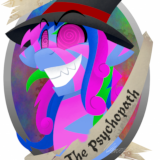


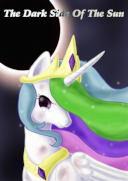

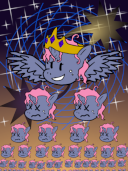
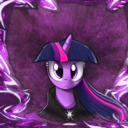
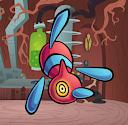






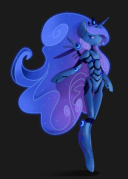
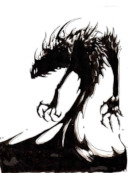


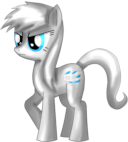






Was this a typo?
I don't understand what happened at all. Can somebody explain to me what happened?
It was very confusing.
I can't tell if I'm not smart enough to figure out what happened or if the story needs work to make it more coherent.
11530822
I'll answer as best I can based on my own knowledge.
What happened was a god, more than likely one alien to the world of the ponies and working off its own standards with quickly gathered info on the ponies, decided to be Celestia for some sort of reason or goal. In doing this its own nature melded and pushed against what it was try to be, not realizing this as it continued with its actions which in turn where torture for the ponies.
I suspect it may have been underdeveloped as it seemed unable to comprehend what it was being told. More so than confusion. But when faced with a cutie mark that was a mark of something above a god and above that. Say the parent of a titan for example or something else depending on the culture. I believe it was a primordial entity, they are entities very similar in description to the black mass in the story. Many primal force entities in cultures around the world are creation itself or the first thing of creation. So actually angering one or doing something you shouldn't have that gets its attention is well... something very very wrong of you to do.
But that's just my best take of the story.
Fascinating. A very intriguing weaving of exonormal events. I do hope you publish more tales of adventure for this young mare, Lavender Staar. With how the ending was, it feels like she's about to get hired as an agent of the crown to deal with cases like this.
11530782
At first yes, but then I made it the name. I thought: "Why not?"
11530884
That's a pretty good approximation. I wanted to do eldritch horror well, but I still have some work to do to get it right.
Something that annoyed me is that eldritch horrors are ALWAYS Cthulu (the recent Batman animated movie called the horror Cthulu in the end) and ALWAYS evil. It seems quite bizarre that something that exists beyond our comprehension acts in a very understandable fashion.
'Celestia' does indeed try to act kind to the ponies like the real Celestia, but it misunderstands many concepts like 'Immersing yourself into a book' and food feeding you and your biome.
I also wanted to show that there are things levels above the eldritch horrors that even they cannot comprehend and fear. Did the thing feel enmity? Was it just curious and trying to understand what was too far below it to? If the ponies' world was alien and difficult to comprehend for the false Celestia, what exactly does that mean for the one two steps above? It did appear around the story a lot after it got Lavender to go to the castle.
There's always a bigger fish until the ocean can hold no more. Then one more appears.
11530889
I was told this by Luna that this seemed like an introductory to a new horror series. I might do more in the future.
That was a good tape. A bit confusing but most horror are and leaving it open only helps to build upon the psychological terror, my only issue was how the name "Lavender" was used at the start then immediately changed to Staar and only mentioned once more in the story, if not for the synopsis, i'd have no idea what the difference is between the two.
11531220
Really? Better go through, then.
This makes no sense to me. Simply nothing for me.
An interesting story. Since you asked for constructive criticism, I'll do my best.
One thing to look at is Staar, the protagonist. I'm not quite sure what vibe I should be getting from her. The intro sets her up as a desperate klutz who can't get hired or hold down a job: we see her searching the classifieds, jumping at the lowliest opportunity, knocking over a cart, and reminiscing about the last time she was fired. I got the picture of someone used to rejection who would probably have low confidence as a result.
But then in the rest of the story, she's remarkably unflappable. Despite all the eldritch things happening in the castle, she never once questions whether the other three job seekers are who they say they are, despite being separated and reunited multiple times and the villain of the piece being an impostor in the guise of a pony. She isn't even intimidated by the rude guard at the start, which is a much more mundane problem.
I can't tell whether she's too naive to recognize the danger she's in - doesn't make sense, given how eldritch this story is - or too hard-boiled to be fazed by it - makes sense at the end, since a cutie mark like this likely means she's seen this before, but also doesn't make sense, because someone that cool should have no trouble getting and holding a job. And if she really was competent, why wouldn't we see her being more proactive about reacting to danger?
For example, why didn't she use her cutie mark when fake Celestia initially transformed? Speaking of that, fake Celestia was surprised at the end when a fourth pony showed up to her job audition, but she saw Staar at the start, when Chocolate Swirl drank the cursed tea. Why didn't she notice anything then?
Of course, a hard-boiled detective who's awful at holding down a job is a fine idea for a character, if you explore it. Real people are full of contradictions; giving these to your OCs and then exploring them is how good characters are written. And Staar had many other hints and angles you could use to develop her. For example, she apparently knows what a freshly born foal's hooves look like. It made me wonder, how does she know this? Does she have kids? Did she used to be a doctor? Was she once simply in the wrong place at the wrong time? Stuff like that is interesting.
Moving on a little. Most short horror stories follow a basic structure, and this one is no different: there's a protagonist (Staar). What ordinary is for them is established (unemployed, seeking work). They do something different, or make a change to their routine (going to Canterlot Castle). Some things start seeming creepy or out of place (lots of things). And then there's a big reveal where it becomes too late to walk away (Celestia impostor being revealed). However, the pacing of these felt a little off in this story.
First, the red flags that something was wrong in the castle came on far too strongly. It's not like you can keep this a secret from your audience; it's right there in the cover art and blurb of the story. But what you do want to watch out for is that here, it felt like any sane person would have ran away long before the big reveal, when there was still time to do so. You can't build tension if your audience is wondering why the protagonist hasn't gotten a clue and fled yet.
This is a bit of a delicate art, but you have some useful tools to work with. First, because your audience is expecting a horror story, you can describe completely normal occurrences in suspiciously high detail and it will come off as sinister. We don't need to know that the sky and the grass are off-color, or that Staar's hoofsteps make the wrong sound for the floor she's walking on. You could simply describe the construction project more, how everything is half-taken apart, and your readers' minds will fill in the blanks about all the things that could be hiding. Mention more things like how the carpet in the waiting room was brown before you bring out the bigger red flags.
Another way to keep your readers on their toes, especially for mid-length stories, is to have several false starts when building up tension, and release it several times by signalling to your audience that everything's okay. Once you've faked your audience out by making something innocuous actually turn out to be innocuous, they'll have to start second-guessing and can't just take it for granted that everything is the fault of the eldritch abomination. And jerking your audience around like this builds tension in the long run, even if you're sacrificing some of it in the moment.
I think the fake Celestia reveal could have been moved back to roughly the midpoint of the story with no issues. Somewhere between a quarter and halfway through the story is usually optimal for pacing out your tension, depending how much detective work you want your protagonist to do afterward to figure out how to beat/escape the monster (horror and mystery go hand in hand). But a lot of your time after the fake Celestia reveal was spent introducing two of the job applicants, and I think the story could have been stronger if we met them ahead of time, before things started getting spooky. This could also help with the issue of how Staar trusts Carrot Shake so readily: it would still be strange that she doesn't suspect he could be an impostor, but at least she'd have met him before.
After the fake Celestia reveal, I think the tea area is your strongest scene. Putting mouths on things that aren't supposed to have them, like liquids, is a quintessential cosmic horror trope, and the tea itself serves a similar function to gory areas in gore-based horror stories without actually warranting a gore tag.
This story has sort of a themed areas thing going on, with each applicant's area based around a different aesthetic, and I think that's both an interesting plot structure and a good literary exercise for practicing writing eldritch stuff in different ways. However, I have three issues with that setup.
First, because the threat level essentially stays constant throughout the story and the characters never catch a break to figure out what's going on, you're missing out on taking advantage of the natural break points that area transitions provide. When your cast goes from one area to another, you could push the immediate threat into the background for a bit, give them some speculation and recovery time while you start building up again to a reveal of what's wrong with this next area. But instead of figuring out what's going on, that time is spent introducing the new applicants, which is another reason I think the story could be stronger if they were introduced earlier.
Second, the areas feel mostly based around the applicants. That's okay, but the applicants frankly aren't very interesting characters and I don't think that using these areas to explore their personalities and fears went anywhere. You could definitely make that work, especially if the story was a little longer and afforded them more time for conversation and character development, but what if you used the separate areas to develop multiple aspects of fake Celestia's personality instead, or approach her from different angles? Part of what makes stories about unknowable abominations interesting is when the story tries to make them knowable, just enough to show off how unknowable they really are. And while we got a little bit of this, showing how fake Celestia might have thought she was giving the applicants what they wanted, I don't feel like she got thoroughly explored at all.
Finally, and perhaps the biggest: you were telling a story about two eldritch abominations, in which the bigger and more eldritch one eventually devoured the lesser one even though the lesser one was responsible for most of the story's problems. It's a cool idea, but in order to pull off an ending like that successfully, you need to be able to foreshadow effectively, and it's very difficult to foreshadow that there's more than one eldritch power at work when each abomination's eldritch happenings don't have a distinctive trademark. Because fake Celestia can do so many things, from tea sewers to eyeball stalks to cursed food to book monsters to twisted architecture, it becomes so much harder to signal to your readers that there are supernatural things going on that aren't coming from her.
The best-written eldritch abominations can coexist together in the same story while avoiding this pitfall, and they do it by having personal brands. As an example, I mentioned earlier how I liked the descriptions on the opening reveal of fake Celestia, and how you gave Chocolate's tea a mouth. What if mouths in places they don't belong were fake Celestia's motif? The cursed food has mouths, the books have mouths, the eyeball stalks have mouths, and so do the twisted buildings. Then anything without a mouth could potentially stand out more as being a sign of Staar's cutie mark. And even in a story with only one monster, doing this still serves to help define the monster's character, and make it less generic and more memorable.
I wish you the best of luck with your future writing, and hope you keep having fun with horror stories!
11651890
Waw. That's extremely detailed and a lot of much needed and very helpful info. Thanks a lot for this.
Some points I'll mention, though. Staar's cutie mark is actually not a real mark, which I think I implied indirectly(maybe not). She can't control it. The thing that devours Fakelestia is essentially always attached to Staar and makes her see and experience things she isn't supposed to. I figured that would have been a good reveal at the end to show why Staar was a ditzy clutz at the beginning but was apathetic to the eldritch happenings later down the line since she's experienced such things already: Far worse things than what happened here. That mark basically has her linked, in a way, to the planes above her, so she's even seen things above what devoured fakelestia.
And I purposefully made it confusing to the reader that there are two eldrich abominations in the castle with only Fakelestia being the most prominent. It's true that I should've though of an identifier to clue the reader in, though. I was just really focused on making it confusing.
Additionally, I didn't want either to come off as good or evil. Since, you know, they're EDLRICH ABOMINATIONS and thus don't have our sense of morality and understanding (which everyone doesn't seem capable of wrapping their heads around, at least in movie and animated media).